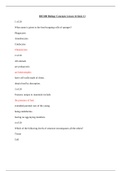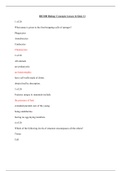Cnidocytes Study guides, Class notes & Summaries
Looking for the best study guides, study notes and summaries about Cnidocytes? On this page you'll find 24 study documents about Cnidocytes.
Page 3 out of 24 results
Sort by
![Cnidaria [PHYLUM] – CH 7](/docpics/5f10e73442df3_767061.jpg)
-
Cnidaria [PHYLUM] – CH 7
- Class notes • 4 pages • 2020
- Available in package deal
-
- $8.99
- + learn more
This chapter summarizes Cnidarians. Emphasis was placed in their classification.

-
BIO100 Biology Concepts Lesson 14 Quiz 11
- Exam (elaborations) • 7 pages • 2018
-
- $14.49
- + learn more
1 of 20 What name is given to the food-trapping cells of sponges? Phagocytes Amoebocytes Cnidocytes Choanocytes 2 of 20 All animals are prokaryotic. are heterotrophic. have cell walls made of chitin. obtain food by absorption. 3 of 20 Features unique to mammals include the presence of hair. extended parental care of the young. being endotherms. having no egg-laying members. 4 of 20 Which of the following levels of structure encompasses all the others? Tissue Cell Organ Organism 5 of 20 Which of ...

-
What name is given to the food-trapping cells of sponges?
- Exam (elaborations) • 7 pages • 2017
-
- $17.49
- + learn more
1 of 20 What name is given to the food-trapping cells of sponges? Phagocytes Amoebocytes Cnidocytes Choanocytes 2 of 20 All animals are prokaryotic. are heterotrophic. have cell walls made of chitin. obtain food by absorption. 3 of 20 Features unique to mammals include the presence of hair. extended parental care of the young. being endotherms. having no egg-laying members. 4 of 20 Which of the following levels of structure encompasses all the others? Tissue Cell Organ Organism 5 of 20 Which of ...

-
BIO100 Biology Concepts Lesson 14 Quiz 11
- Exam (elaborations) • 7 pages • 2017
-
- $17.49
- + learn more
1 of 20 What name is given to the food-trapping cells of sponges? Phagocytes Amoebocytes Cnidocytes Choanocytes 2 of 20 All animals are prokaryotic. are heterotrophic. have cell walls made of chitin. obtain food by absorption. 3 of 20 Features unique to mammals include the presence of hair. extended parental care of the young. being endotherms. having no egg-laying members. 4 of 20 Which of the following levels of structure encompasses all the others? Tissue Cell Organ Organism 5 of 20 Which of ...

How much did you already spend on Stuvia? Imagine there are plenty more of you out there paying for study notes, but this time YOU are the seller. Ka-ching! Discover all about earning on Stuvia


